Fractal Characterization on Three-Dimensional Tortuosity of Fault Tectonic
Abstract
1. Introduction
2. Objects and Methodology of Research
2.1. Methodology
2.2. Research Object
2.3. Geological Prospecting by the 3D Seismic Exploration
3. Results and Discussion
3.1. Analysis of Faults by 3D Seismic Exploration
3.2. Key Parameters of Faults Derived by 3D Seismic Exploration
3.3. Estimation on Df3
3.4. Estimation on DT3
3.5. Validation of the Calculation Method on DT3
3.6. Implication
4. Conclusions
- We proposed a fractal characterization method on the 3D fault tortuosity (DT3), and the calculation model on DT3 is a function of Lmin, Lmax, τav, and Df3. The key parameters for calculating DT3 can be obtained through this seismic exploration technique.
- Through the proposed method, the calculated DT3 values for the four different geological units are determined to be 1.90737, 1.96026, 2.10998, and 1.69579, respectively. The rationality of the proposed model on DT3 was examined by the classical analytic relationships on the tortuosity and porosity of the fault (fracture) and DT3 vs. Df3.
- Compared with the conventional fractal characterization method by Df3, the proposed fractal characterization method on DT3 can more accurately and comprehensively symbolize the complexity and heterogeneity of the fault network system in the 3D space, which achieves a breakthrough in the fractal characterization of the fault network system.
- It is worth carrying out further study to explore the impacts on the transportation and occurrence of oil and gas exploration by using DT3 in combination with Df3, which can provide the theoretical foundation and technical support for oil and gas exploration.
- Among the first three geological units, the DT3 of geological unit Ⅰ is the smallest, which indicates that the tortuosity of the fissures in geological unit Ⅰ is the smallest, which is the most favorable for oil and gas collection.
Author Contributions
Funding
Data Availability Statement
Conflicts of Interest
References
- Ahmed, K.S.; Liu, K.; Harouna, M.; Liu, J.; Twinomujuni, L.; Abdoul Aziz, H.B.; Kun, J.; Ahmed, H.A. Integrated 3D Geological Analysis of Hydrocarbon Maturation and Migration in Rift Basins: Insights from the Niger Chad Basin. J. Afr. Earth Sci. 2024, 210, 105157. [Google Scholar] [CrossRef]
- Fan, C.; Xie, H.; Li, H.; Zhao, S.; Shi, X.; Liu, J.; Meng, L.; Hu, J.; Lian, C. Complicated Fault Characterization and Its Influence on Shale Gas Preservation in the Southern Margin of the Sichuan Basin, China. Lithosphere 2022, 2022, 8035106. [Google Scholar] [CrossRef]
- Ma, Y.; Cai, X.; Yun, L.; Li, Z.; Li, H.; Deng, S.; Zhao, P. Practice and Theoretical and Technical Progress in Exploration and Development of Shunbei Ultra-Deep Carbonate Oil and Gas Field, Tarim Basin, NW China. Pet. Explor. Dev. 2022, 49, 1–20. [Google Scholar] [CrossRef]
- Wang, X.; Zhou, X.; Li, S.; Zhang, N.; Ji, L.; Lu, H. Mechanism Study of Hydrocarbon Differential Distribution Controlled by the Activity of Growing Faults in Faulted Basins: Case Study of Paleogene in the Wang Guantun Area, Bohai Bay Basin, China. Lithosphere 2022, 2021, 7115985. [Google Scholar] [CrossRef]
- Fang, R.; Jiang, Y.; Luo, Y.; Wang, Z.; Jiang, C.; Li, S.; Qi, L.; Yan, X. Hydrocarbon Geological Characteristics and Factors Controlling Hydrocarbon Accumulation of Jurassic Da’anzhai Continental Shale. Minerals 2023, 14, 11. [Google Scholar] [CrossRef]
- Zhou, Q.; Liu, D.; Lin, X. Pre-Evaluation of Fault Stability for Underground Mining Based on Geomechanical Fault-Slip Analysis. Geomat. Nat. Hazards Risk 2022, 13, 400–413. [Google Scholar] [CrossRef]
- Dong, Y.; Zeng, J.; Dong, X.; Li, C.; Liu, Y. The Control Effect of Normal Faults and Caprocks on Hydrocarbon Accumulation: A Case Study from the Binhai Fault Nose of the Huanghua Depression, Bohai Bay Basin, China. J. Pet. Sci. Eng. 2022, 218, 110918. [Google Scholar] [CrossRef]
- Zhao, X.; Yang, B.; Yuan, S.; Shen, Z.; Feng, D. Seepage–Fractal Model of Embankment Soil and Its Application. Fractal Fract. 2022, 6, 277. [Google Scholar] [CrossRef]
- Peng, Y.; Tang, S.; Huang, J.; Tang, C.; Wang, L.; Liu, Y. Fractal Analysis on Pore Structure and Modeling of Hydration of Magnesium Phosphate Cement Paste. Fractal Fract. 2022, 6, 337. [Google Scholar] [CrossRef]
- Wang, A.; Wang, L. A Fractal-Based Quantitative Method for the Study of Fracture Evolution of Coal under Different Confining Pressures. Fractal Fract. 2024, 8, 159. [Google Scholar] [CrossRef]
- Pang, M.; Pan, H.; Zhu, S.; Zhang, Y.; Zhang, T. Experimental Investigation of the Fractal-Permeability Properties of Locally Fractured Coal Bodies around Gas Extraction Boreholes. Fractal Fract. 2023, 7, 574. [Google Scholar] [CrossRef]
- Yuan, B.; Li, Z.; Chen, W.; Zhao, J.; Lv, J.; Song, J.; Cao, X. Influence of Groundwater Depth on Pile–Soil Mechanical Properties and Fractal Characteristics under Cyclic Loading. Fractal Fract. 2022, 6, 198. [Google Scholar] [CrossRef]
- Zhu, W.; Yalcin, B.; Khirevich, S.; Patzek, T.W. Fault Traces: Generation of Fault Segments and Estimation of Their Fractal Dimension. Lithosphere 2021, 2021, 4991604. [Google Scholar] [CrossRef]
- Cui, Z.; Zhou, J.; Luo, K.; Lu, M. Fractal Structure Characteristics and Prospecting Direction of Dispersed Metals in the Eastern Guizhou Pb–Zn Metallogenic Belt, SW China. Minerals 2022, 12, 1567. [Google Scholar] [CrossRef]
- Li, F.; Hao, T.; Wang, G.; Tang, Y.; Yuan, M.; Zhao, L. Mechanical Properties and Fractal Characteristics of Fractured Coal under Different Gas Pressures. Nat. Resour. Res. 2024, 33, 793–812. [Google Scholar] [CrossRef]
- Zhou, Z.; Roubinet, D.; Tartakovsky, D.M. Thermal Experiments for Fractured Rock Characterization: Theoretical Analysis and Inverse Modeling. Water Resour. Res. 2021, 57, e2021WR030608. [Google Scholar] [CrossRef]
- Zhang, W.; Zhou, G.; Zhang, G.; Duan, J.; Kong, Y.; Jiang, T. Study on 3D Spatial Characterization Analysis and Water Injection Seepage Numerical Simulation of Coal Micro-Pore/Fracture. Energy Sources Part A Recovery Utilization Environ. Effects 2020, 1–15. [Google Scholar] [CrossRef]
- Oynakov, E.; Botev, E. Fractal Properties of Seismicity and Active Faults in Balkans. J. Volcanol. Seismol. 2021, 15, 483–490. [Google Scholar] [CrossRef]
- Xu, P.; Chen, Z.; Qiu, S.; Yang, M.; Liu, Y. An Analytical Model for Pore and Tortuosity Fractal Dimensions of Porous Media. Fractals 2021, 29, 2150156. [Google Scholar] [CrossRef]
- Ross, Z.E.; Cochran, E.S.; Trugman, D.T.; Smith, J.D. 3D Fault Architecture Controls the Dynamism of Earthquake Swarms. Science 2020, 368, 1357–1361. [Google Scholar] [CrossRef]
- Lotfi, M.; Javaherian, A.; Varnousfaderani, S.R.; Amindavar, H.R. Mapping Channel Boundaries in Seismic Data Based on an Improved Partial Area Effect. J. Pet. Sci. Eng. 2022, 212, 110263. [Google Scholar] [CrossRef]
- Zhao, L.; Cai, M.; Ding, R.; Zhang, Y.; Zhao, S.; Zhang, J.; Yang, J. A 3D Organized Point Cloud Clustering Algorithm for Seismic Fault Data Based on Region Growth. Comput. Geosci. 2023, 27, 1165–1181. [Google Scholar] [CrossRef]
- Zhang, Z.; Liu, G.; Wang, X.; Li, B.; Liu, H. Fractal Characterization on Fracture Volume in Coal Based on Ct Scanning: Principle, Methodology, and Implication. Fractals 2022, 30, 2250124. [Google Scholar] [CrossRef]
- Ji, J.; Song, X.; Li, S.; Xu, F.; Song, G.; Shi, Y.; Yi, J. Study on the Effect of Fracture Morphology on Fracture Deformation Based on the Thermal-Hydraulic-Chemical-Deformation Coupling Model. Energy 2023, 282, 128628. [Google Scholar] [CrossRef]
- McBeck, J.; Renard, F. Deriving Three-dimensional Properties of Fracture Networks from Two-dimensional Observations in Rocks Approaching Failure under Triaxial Compression: Implications for Fluid Flow. Water Resour. Res. 2022, 58, e2022WR032783. [Google Scholar] [CrossRef]
- Ma, D.; Li, Q.; Cai, K.; Zhang, J.; Li, Z.; Hou, W.; Sun, Q.; Li, M.; Du, F. Understanding Water Inrush Hazard of Weak Geological Structure in Deep Mine Engineering: A Seepage-Induced Erosion Model Considering Tortuosity. J. Cent. South Univ. 2023, 30, 517–529. [Google Scholar] [CrossRef]
- Luo, L.; Jin, J.; Wei, W.; Cai, J. An Analysis of Fractal Dimension and Tortuosity Based on 2D Numerical Reconstruction Model of Reservoir Rocks. Interpretation 2019, 7, SJ1–SJ6. [Google Scholar] [CrossRef]
- Thanh, L.D.; Jougnot, D.; Van Do, P.; Van Nghia A, N.; Tuyen, V.P.; Ca, N.X.; Hien, N.T. A Physically Based Model for the Electrical Conductivity of Partially Saturated Porous Media. Geophys. J. Int. 2020, 223, 993–1006. [Google Scholar] [CrossRef]
- Zhang, B.; Tong, Y.; Du, J.; Hussain, S.; Jiang, Z.; Ali, S.; Ali, I.; Khan, M.; Khan, U. Three-Dimensional Structural Modeling (3D SM) and Joint Geophysical Characterization (JGC) of Hydrocarbon Reservoir. Minerals 2022, 12, 363. [Google Scholar] [CrossRef]
- Dutilleul, J.; Bourlange, S.; Géraud, Y. Porosity and Compaction State at the Active Pāpaku Thrust Fault in the Frontal Accretionary Wedge of the North Hikurangi Margin. Geochem. Geophys. Geosyst. 2021, 22, e2020GC009325. [Google Scholar] [CrossRef]
- Sun, S.; Huang, S.; Gomez-Rivas, E.; Griera, A.; Liu, B.; Xu, L.; Wen, Y.; Dong, D.; Shi, Z.; Chang, Y.; et al. Characterization of Natural Fractures in Deep-Marine Shales: A Case Study of the Wufeng and Longmaxi Shale in the Luzhou Block Sichuan Basin, China. Front. Earth Sci. 2023, 17, 337–350. [Google Scholar] [CrossRef]
- Pei, X. Signal Acquisition Method for 3D Seismic Exploration in High-Density Coal Mining Area. Arab. J. Geosci. 2020, 13, 712. [Google Scholar] [CrossRef]
- Da Col, F.; Papadopoulou, M.; Koivisto, E.; Sito, Ł.; Savolainen, M.; Socco, L.V. Application of Surface-wave Tomography to Mineral Exploration: A Case Study from Siilinjärvi, Finland. Geophys. Prospect. 2020, 68, 254–269. [Google Scholar] [CrossRef]
- Zou, G.; Liu, H.; Ren, K.; Deng, B.; Xue, J. Automatic Recognition of Faults in Mining Areas Based on Convolutional Neural Network. Energies 2022, 15, 3758. [Google Scholar] [CrossRef]
- Wang, F.; Cheng, H. A Fractal Permeability Model for 2D Complex Tortuous Fractured Porous Media. J. Pet. Sci. Eng. 2020, 188, 106938. [Google Scholar] [CrossRef]
- Chen, A.; Miao, T.; Li, Z.; Zhang, H.; Jiang, L.; Liu, J.; Yan, C.; Yu, B. Fractal Monte Carlo Simulations of the Effective Permeability for a Fracture Network. Fractals 2022, 30, 2250074. [Google Scholar] [CrossRef]
- Liu, H.; Li, W.; Gu, S.; Cheng, L.; Wang, Y.; Xu, J. Three-Dimensional Modeling of Fault Geological Structure Using Generalized Triangular Prism Element Reconstruction. Bull. Eng. Geol. Environ. 2023, 82, 118. [Google Scholar] [CrossRef]
- Zhang, Z.; Liu, G.; Chang, P.; Wang, X.; Lin, J. Fractal Characteristics for Coal Chemical Structure: Principle, Methodology and Implication. Chaos Solitons Fractals 2023, 173, 113699. [Google Scholar] [CrossRef]
- Kou, J.-L.; Tang, X.-M.; Zhang, H.-Y.; Lu, H.-J.; Wu, F.-M.; Xu, Y.-S.; Dong, Y.-S. Tortuosity for Streamlines in Porous Media. Chin. Phys. B 2012, 21, 44701. [Google Scholar] [CrossRef]
- Liu, G.; Zhang, Z.; Cao, Y.; Wang, X.; Liu, H.; Li, B.; Si, N.; Guan, W. An Analogical Method on Fractal Dimension for Three-Dimensional Fracture Tortuosity in Coal Based on Ct Scanning. Fractals 2023, 31, 2350072. [Google Scholar] [CrossRef]
- Wang, F.; Cheng, H. Effect of tortuosity on the stress-dependent permeability of tight sandstones: Analytical modelling and experimentation. Mar. Pet. Geol. 2020, 120, 104524. [Google Scholar] [CrossRef]
- Hu, Y.; Wang, Q.; Zhao, J.; Xie, S.; Jiang, H. A Novel Porous Media Permeability Model Based on Fractal Theory and Ideal Particle Pore-Space Geometry Assumption. Energies 2020, 13, 510. [Google Scholar] [CrossRef]
- Su, H.; Zhang, Y.; Xiao, B.; Huang, X.; Yu, B. A Fractal-Monte Carlo Approach to Model Oil and Water Two-Phase Seepage in Low-Permeability Reservoirs with Rough Surfaces. Fractals 2021, 29, 2150003. [Google Scholar] [CrossRef]
- Zhang, G.; Guo, J.; Xu, B.; Xu, L.; Dai, Z.; Yin, S.; Soltanian, M.R. Quantitative Analysis and Evaluation of Coal Mine Geological Structures Based on Fractal Theory. Energies 2021, 14, 1925. [Google Scholar] [CrossRef]
- Shmela, A.K.; Paton, D.A.; Collier, R.E.; Bell, R.E. Normal Fault Growth in Continental Rifting: Insights from Changes in Displacement and Length Fault Populations Due to Increasing Extension in the Central Kenya Rift. Tectonophysics 2021, 814, 228964. [Google Scholar] [CrossRef]
- Ma, D.; Duan, H.; Zhang, J. Solid Grain Migration on Hydraulic Properties of Fault Rocks in Underground Mining Tunnel: Radial Seepage Experiments and Verification of Permeability Prediction. Tunn. Undergr. Space Technol. 2022, 126, 104525. [Google Scholar] [CrossRef]
- Ma, D.; Duan, H.; Zhang, J.; Liu, X.; Li, Z. Numerical Simulation of Water–Silt Inrush Hazard of Fault Rock: A Three-Phase Flow Model. Rock Mech. Rock Eng. 2022, 55, 5163–5182. [Google Scholar] [CrossRef]
- Wang, W.; Pang, X.; Chen, Z.; Chen, D.; Wang, Y.; Yang, X.; Luo, B.; Zhang, W.; Zhang, X.; Li, C.; et al. Quantitative Evaluation of Transport Efficiency of Fault-Reservoir Composite Migration Pathway Systems in Carbonate Petroliferous Basins. Energy 2021, 222, 119983. [Google Scholar] [CrossRef]
- Zhang, Z.; Liu, G.; Wang, X.; Lv, R.; Liu, H.; Lin, J.; Barakos, G.; Chang, P. A Fractal Langmuir Adsorption Equation on Coal: Principle, Methodology and Implication. Chem. Eng. J. 2024, 488, 150869. [Google Scholar] [CrossRef]
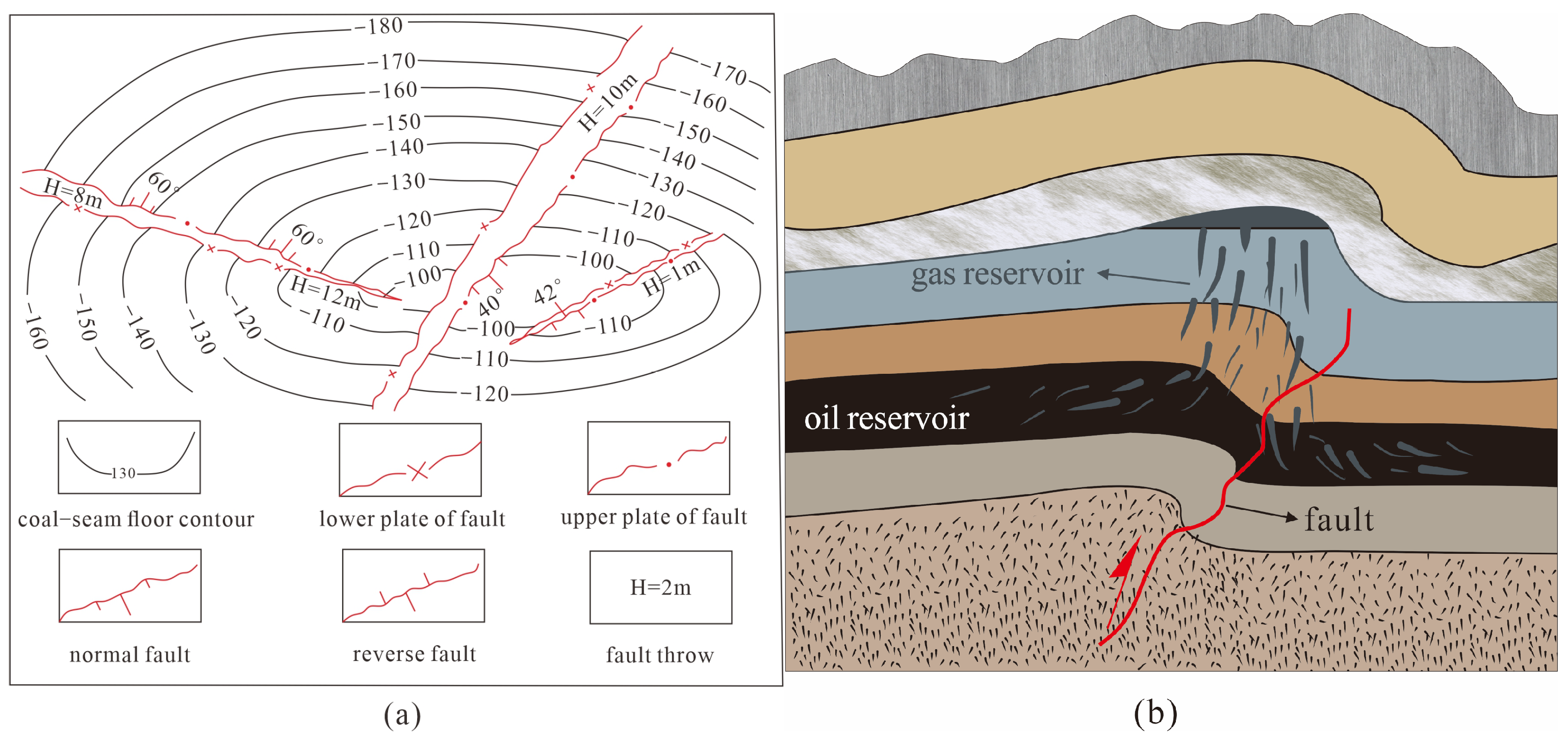
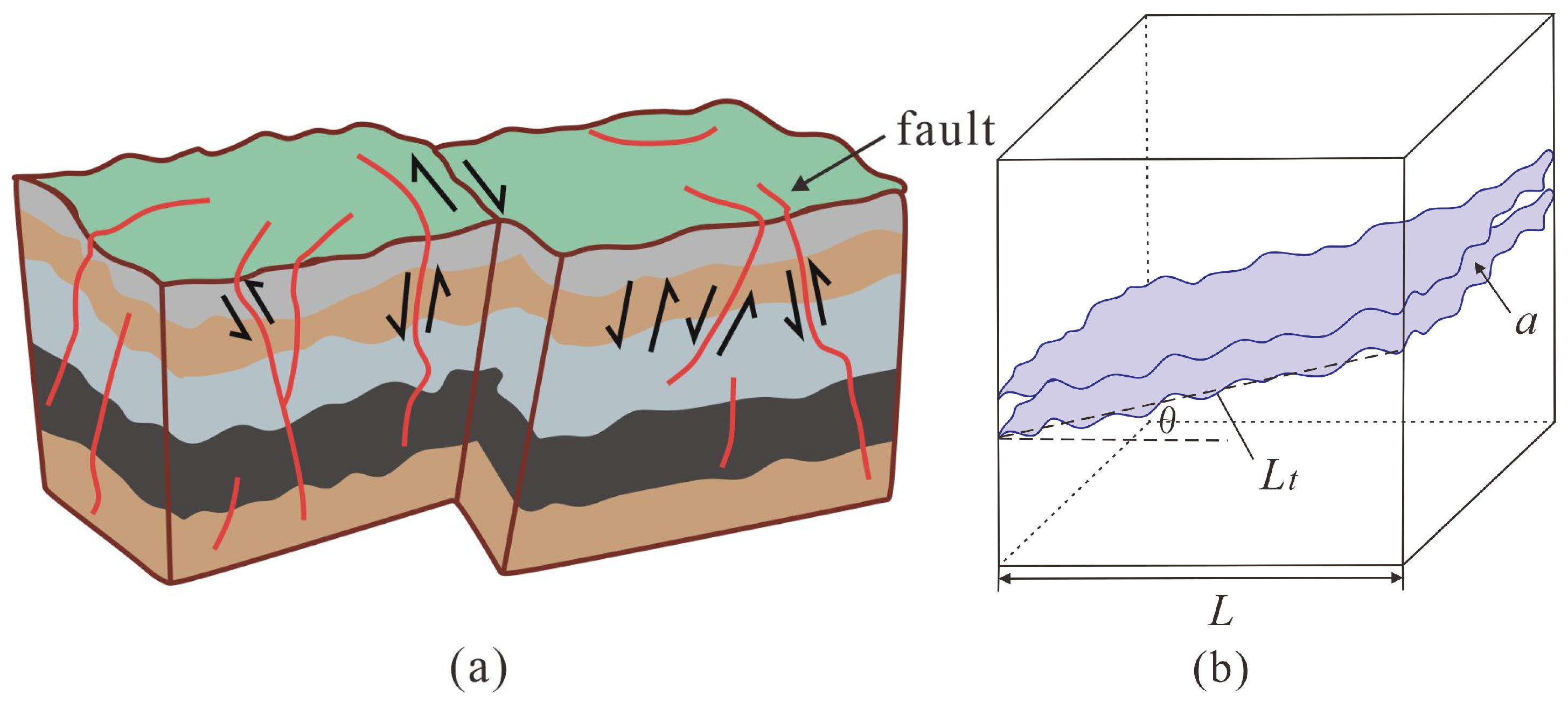


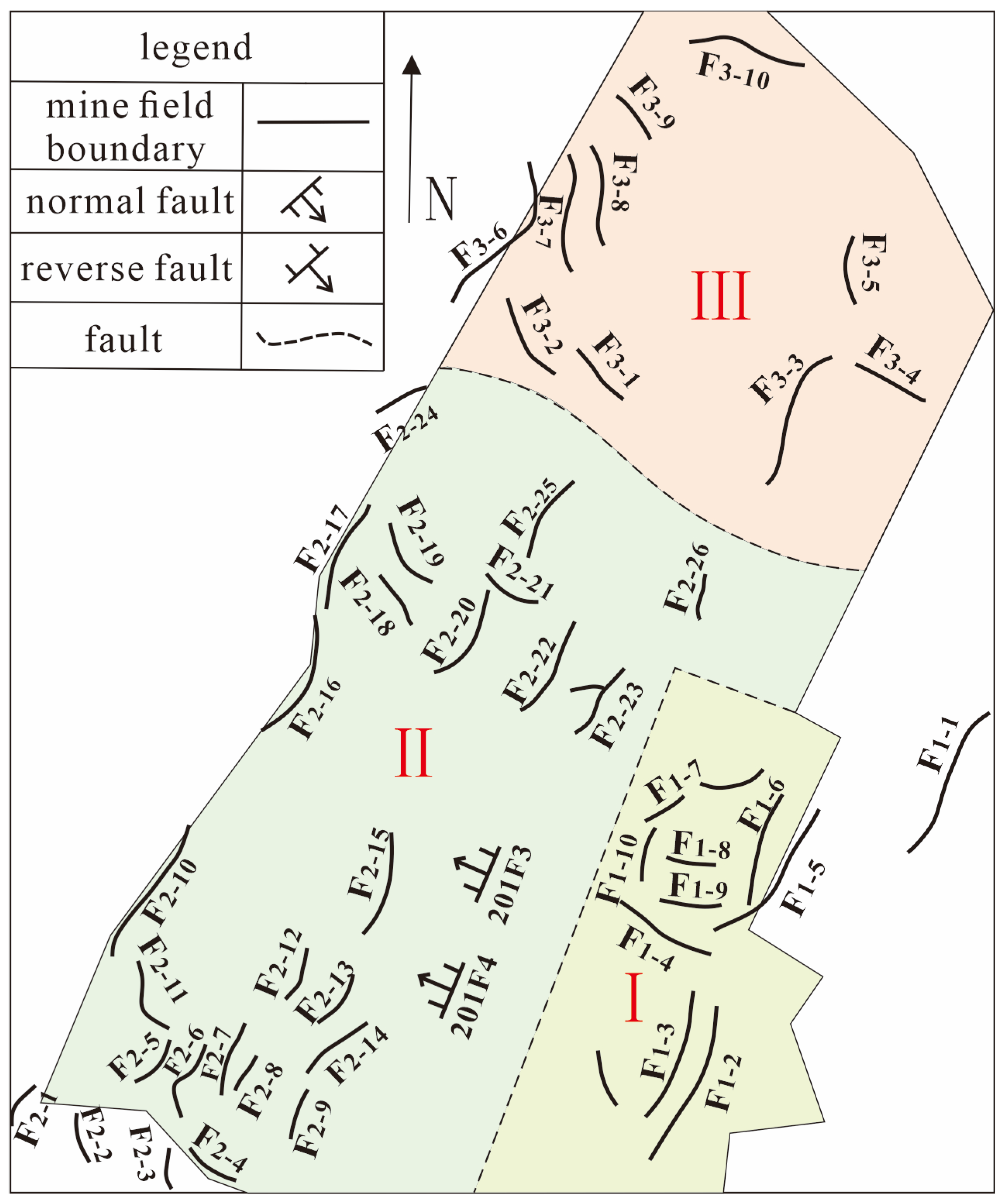
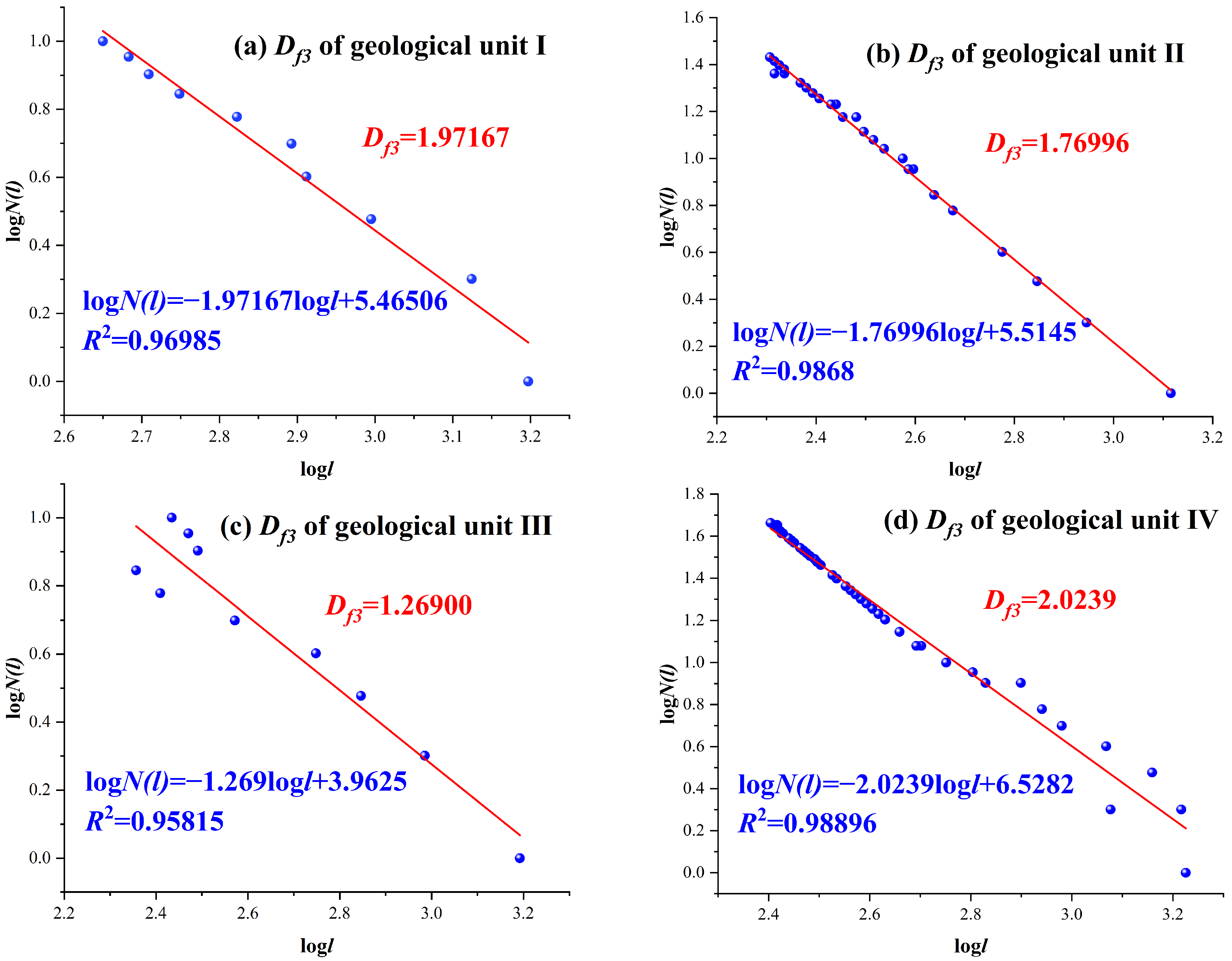

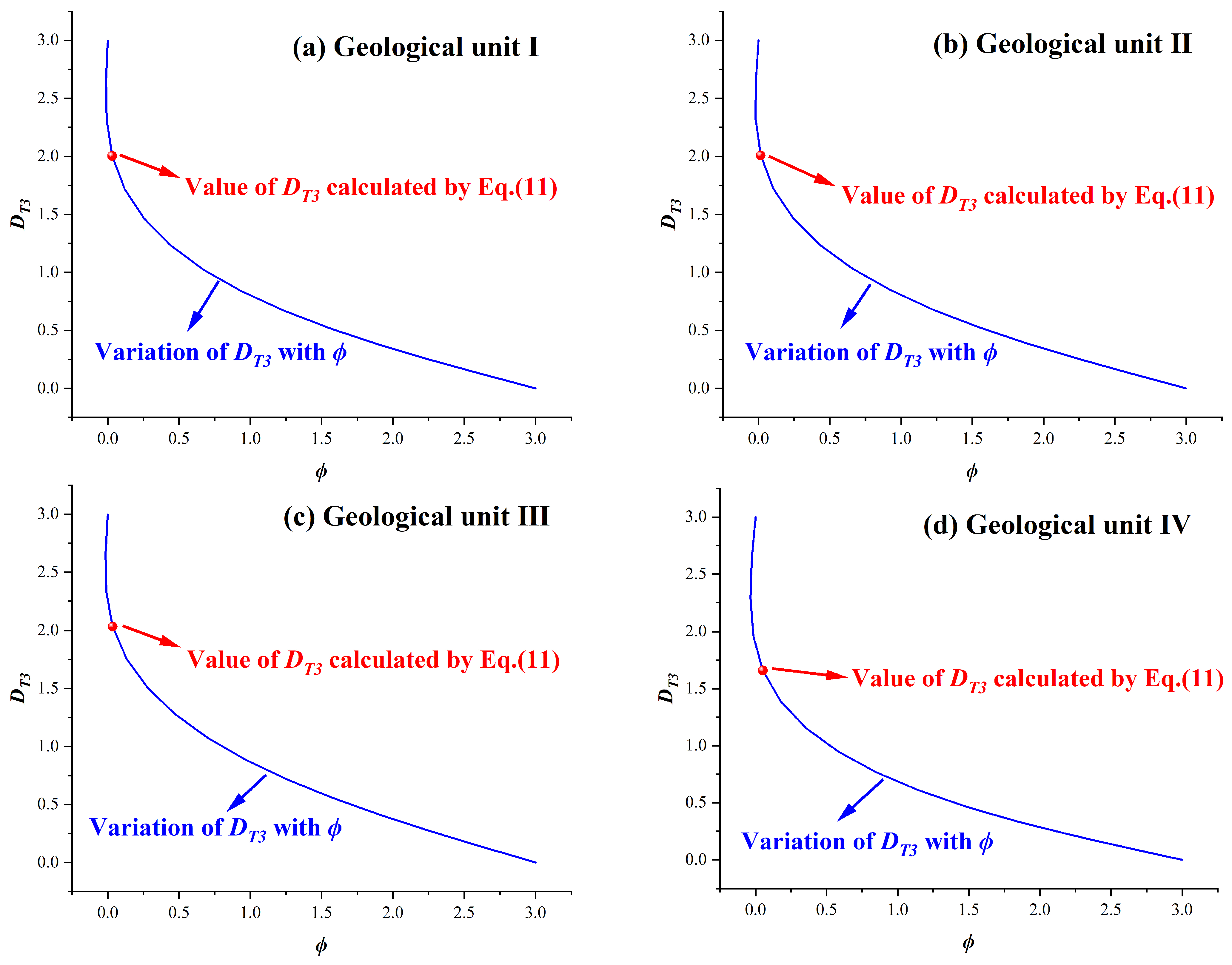
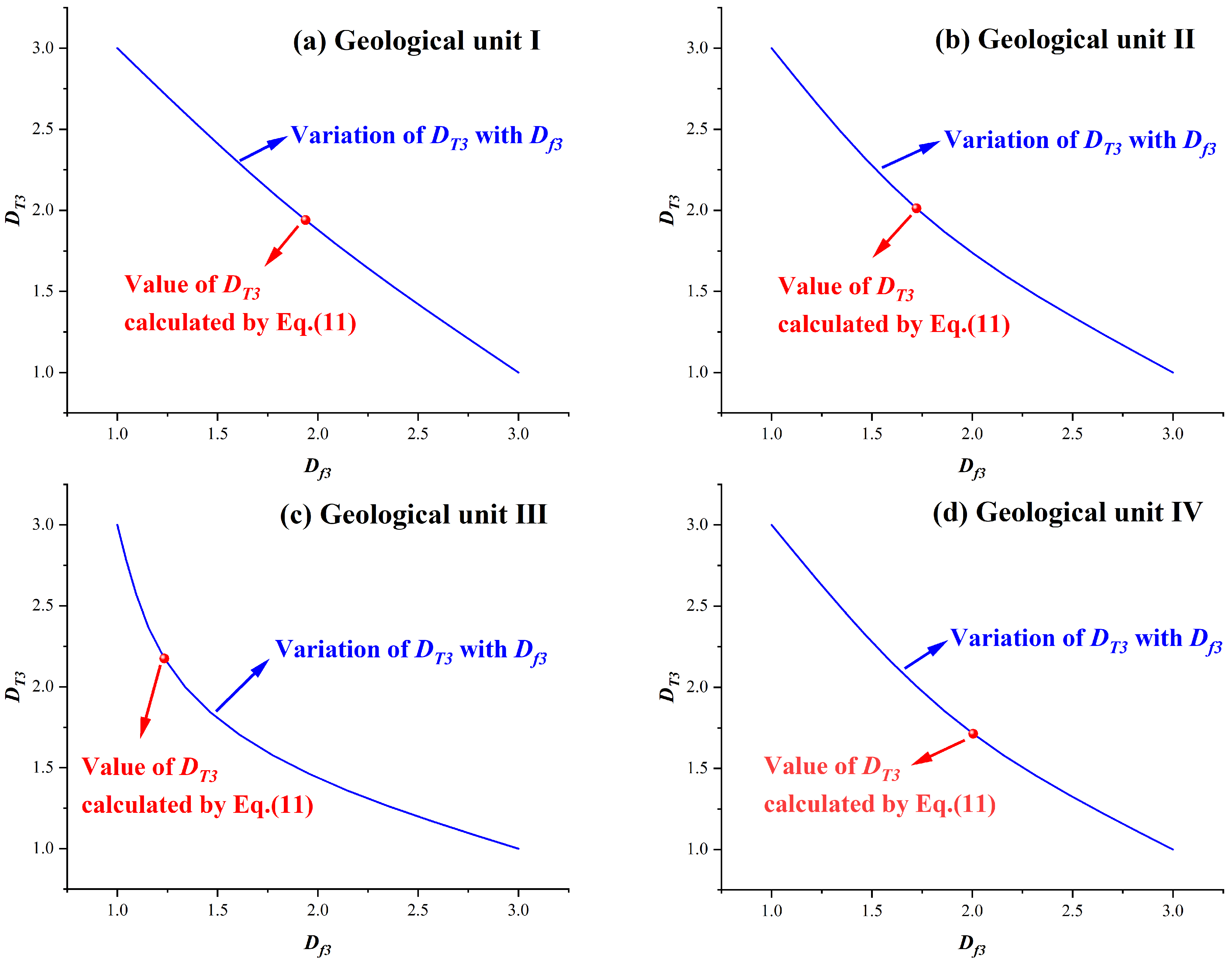
| Item | Parameter |
|---|---|
| Type of observing system | 8-wire, 8-gun, harnessed |
| Receiving channels/channel | 384 (8 × 48 = 384) |
| Number of receiving wires (bar) | 8 |
| Motivation method | Midpoint excitation |
| Receiver line distance (m) | 40 |
| Receiver channel distance (m) | 20 |
| Excitation line distance (m) | 20 |
| Shot interval (m) | 80 |
| CDP grid | 10 m × 10 m |
| Fold (time) | 24 (vertical 6 × horizontal 4) |
| Offsetmax (m) | 523 |
| Offsetmin (m) | 0 |
| Geological Unit | lmin (m) | lmax (m) | ϕ | τav |
|---|---|---|---|---|
| Ⅰ | 55 | 940 | 0.05399 | 9.64131 |
| Ⅱ | 35 | 670 | 0.02649 | 19.25248 |
| Ⅲ | 59 | 598 | 0.01815 | 27.91459 |
| Ⅳ | 35 | 940 | 0.04029 | 12.7903 |
Disclaimer/Publisher’s Note: The statements, opinions and data contained in all publications are solely those of the individual author(s) and contributor(s) and not of MDPI and/or the editor(s). MDPI and/or the editor(s) disclaim responsibility for any injury to people or property resulting from any ideas, methods, instructions or products referred to in the content. |
© 2024 by the authors. Licensee MDPI, Basel, Switzerland. This article is an open access article distributed under the terms and conditions of the Creative Commons Attribution (CC BY) license (https://creativecommons.org/licenses/by/4.0/).
Share and Cite
Lv, R.; Han, X.; Liu, G.; Zhang, Z.; Lin, J.; Barakos, G.; Chang, P. Fractal Characterization on Three-Dimensional Tortuosity of Fault Tectonic. Fractal Fract. 2024, 8, 572. https://doi.org/10.3390/fractalfract8100572
Lv R, Han X, Liu G, Zhang Z, Lin J, Barakos G, Chang P. Fractal Characterization on Three-Dimensional Tortuosity of Fault Tectonic. Fractal and Fractional. 2024; 8(10):572. https://doi.org/10.3390/fractalfract8100572
Chicago/Turabian StyleLv, Runsheng, Xinya Han, Gaofeng Liu, Zhen Zhang, Jia Lin, George Barakos, and Ping Chang. 2024. "Fractal Characterization on Three-Dimensional Tortuosity of Fault Tectonic" Fractal and Fractional 8, no. 10: 572. https://doi.org/10.3390/fractalfract8100572
APA StyleLv, R., Han, X., Liu, G., Zhang, Z., Lin, J., Barakos, G., & Chang, P. (2024). Fractal Characterization on Three-Dimensional Tortuosity of Fault Tectonic. Fractal and Fractional, 8(10), 572. https://doi.org/10.3390/fractalfract8100572










